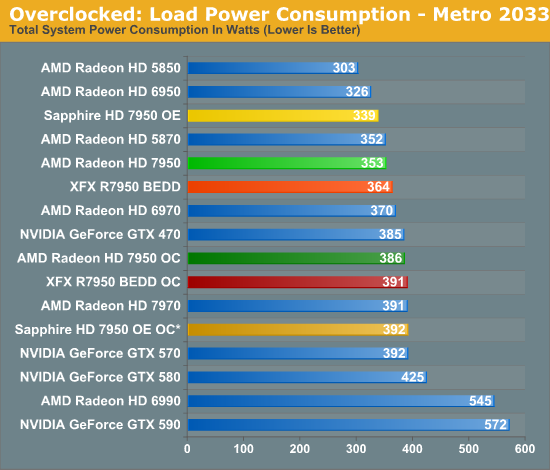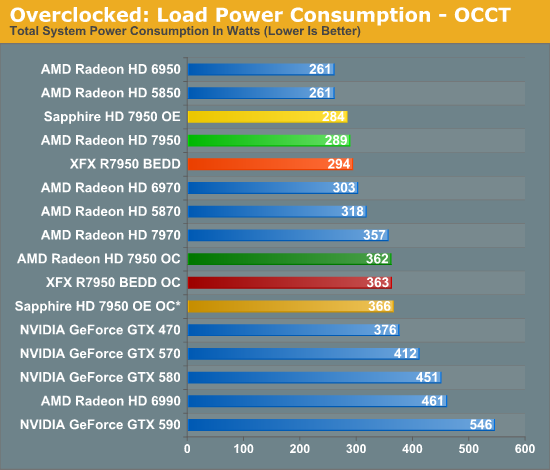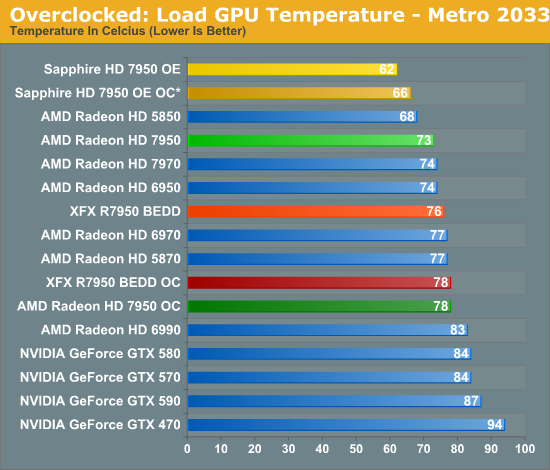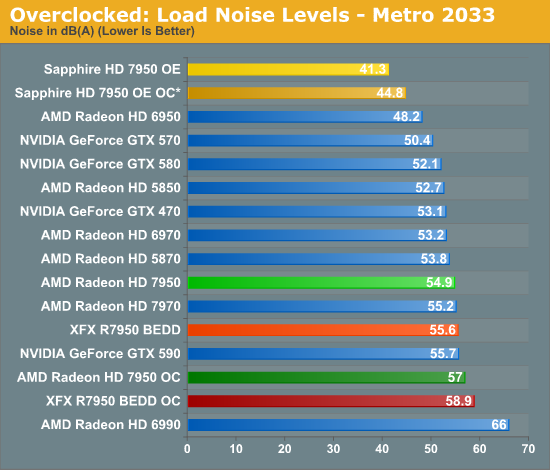AMD Radeon HD 7950 Review Feat. Sapphire & XFX: Sewing Up The High-End Market
by Ryan Smith on January 31, 2012 9:02 AM ESTOverclocking: Power, Temp, & Noise
In their marketing materials AMD is heavily pushing overclocking, and they have good reason to. With the 7970 we’ve established that Tahiti has quite a bit of overclocking headroom, and as the 7950 is clocked lower by default this opens up that headroom even further. Realistically AMD’s binning process means that the best clocking Tahiti GPUs are going to be allocated to the 7970 unless they have failed shaders, but even with that there’s quite a bit of potential on paper.
As with overclocking the 7970, our goal overclocking the 7950 is to see how much you can get for free; that is without any voltage adjustments. AMD’s reference PCBs are not particularly overbuilt for overclocking—cards like that will come later—so sticking to the reference voltage is the safest option, not to mention the easiest. With the 7970 we were able to get 200MHz (22%) overclocks without any voltage adjustment, and we’re hoping for the same out of the 7950.
With that said, we quickly ran into a wall on one card: the Sapphire 7950. Sapphire’s low VID of 0.993v may be great for temperature and noise at stock, but it’s not doing overclocking any favors. We only hit 950MHz at that voltage. As the Sapphire was the odd man out—every other card was at 1.093v—we did end up overvolting the Sapphire to 1.093v to see what it was capable of when put on similar footing as the rest of our cards.
After bringing up the voltage of our Sapphire card, all of our 7950s ended up overclocking to very similar levels. Our Sapphire and AMD cards topped out at 1025MHz core, a 225MHz (28%) overclock over a stock 7950 and a 125MHz (14%) overclock over the Sapphire’s factory overclock, while our XFX card reached 1050MHz, a 150MHz (17%) overclock beyond XFX’s factory overclock. Meanwhile the memory clocks on all of our cards topped out at 5.8GHz, beyond which we’d start seeing performance regressions from error correction on the memory bus.
| Radeon HD 7950 Overclocking | |||||
| AMD Radeon HD 7950 | Sapphire HD 7950 Overclock Edition | XFX R7950 BEDD | |||
| Shipping Core Clock | 800MHz | 900MHz | 900MHz | ||
| Shipping Memory Clock | 5GHz | 5GHz | 5.5GHz | ||
| Shipping Voltage | 1.093v | 0.993v | 1.093v | ||
| Overclock Core Clock | 1025MHz | 1025MHz | 1050MHz | ||
| Overclock Memory Clock | 5.8GHz | 5.8GHz | 5.8GHz | ||
| Overclock Voltage | 1.093v | 1.093v | 1.093v | ||
As you can imagine, with such similar overclocks, gaming performance on all 4 cards ended up being very similar. So we’ll get to gaming performance in a minute, while we’ll start with power, temperature, & noise.


Even though we’re not increasing the voltage on our AMD and XFX cards, merely overclocking them and raising the PowerTune limit to avoid throttling does drive the power consumption up. As is typical with heavily overclocked cards, overclocking quickly drives up power consumption and the 7950s are no exception. After overclocking power consumption is almost identical to the stock 7970, so while you can get 7970 performance you still need to pay the price with 7970 power consumption. Meanwhile it’s interesting to note that even with the extra 0.1v we’ve given the Sapphire card its final power consumption is only ever so slightly higher than the other 7950s, proving that voltage is the great equalizer in this case.


With the increase in power comes an increase in temperatures. The Sapphire card still does very well here staying in the low 70s even under OCCT, while the reference and XFX cards hit the high 70s under Metro and mid 80s under OCCT. As we’ve yet to really ascertain what the thermal limits are for Tahiti, it’s not clear whether there’s too much thermal headroom left for the GPU, particularly under OCCT.


Last but not least we have load noise. The Sapphire card is once more a stellar performer, and we still can’t get it above 50dB even with OCCT. Unfortunately the XFX 7950 BEDD has its biggest fallout yet—it may be able to overclock well, but at 64dB under OCCT the performance isn’t going to be worth the immense amount of noise it creates to move enough air to keep the GPU cool.










259 Comments
View All Comments
MrBungle123 - Tuesday, January 31, 2012 - link
I don't think Anandtech is read by the "average user"... I would assume mostly gamers, enthusiasts, and IT pros here. Besides who buys 1920x1080 monitors? If the monitor isn't 1920x1200 or higher its not worth buying.Ryan Smith - Tuesday, January 31, 2012 - link
Hi poohbear;When drawing out the tests for the current GPU benchmark suite we debated between 1920x1200 and 1920x1080. Ultimately it was decided that 1920x1200 would be more useful for our needs and that 1920x1080 would be unnecessary; 1920x1080 is only slightly lower in resolution, so our 1920x1200 numbers are only slightly worse in performance than they would be with 1920x1080. The two should be treated as the same, as there's generally not nearly enough of a difference to matter.
-Thanks
Ryan Smith
Pantsu - Tuesday, January 31, 2012 - link
It seems there's two choices for 7950, either a 450€+ custom OC card or a "v2" reference cheapo-PCB cards that go for 400€ in Europe. It would certainly be interesting to get a detailed look at how much of a difference that makes. To me those "v2" cards look a bit too nerfed in terms of VRM and cooling.IMO 7950 is priced accordingly and is no question better than a GTX 580 by any metric really. That's enough to justify a similar price. It's up to Nvidia to drop the GTX 580 price to compete, but I doubt they'll do that, and instead wait for GK104 to save the day. If it is a success we could see prices drop fast in the high end, but Nvidia isn't known for its low pricing, and neither does it have any need to try grab market share by undercutting its profits. There's a good cap between 7800 and 7900 and they could just occupy it with a GK104 and call it a day, until they get their big chip ready.
marc1000 - Tuesday, January 31, 2012 - link
Any word on 7870 from amd?UMADBRO - Tuesday, January 31, 2012 - link
Feb 15marc1000 - Tuesday, January 31, 2012 - link
Ty!just4U - Tuesday, January 31, 2012 - link
That Sapphire cooler looks pretty much like their Dirt3 Edition 6950s one. A slightly different plastic shroud but fan's and underlay seem mostly the same.. atleast in the picture views I've seen.gamoniac - Tuesday, January 31, 2012 - link
I found that, in IE 9, I have to click on the "Back" button on the browser six to seven times to actually go back to the main page. Taking a closer look at it, I noticed there are a bunch of "Share this Page" history item between this page (Ryan's HD7950 Review) and the main page that took place without my knowledge. Would this be a site bug or a advertisement bug?Ryan Smith - Tuesday, January 31, 2012 - link
To the best of my knowledge (please keep in mind that I'm not responsible for site development), that's not something the site should be doing. In which case it could very well be an ad bug. If it continues to happen you should be able to use the IE9 developer tools (built-in, F12), to try to narrow down what exactly it is you're seeing.gamoniac - Tuesday, January 31, 2012 - link
Without spending too much time on it, I can see that there were a bunch of frame navigation caused by sharethis.com, which I think is the likely culprit. I am able to reproduce this issue on two separate Win7 SP1 machines; one of them is clean with almost installed except for the usual PDF reader and some benchmarking tools.Check out these three images I uploaded:
In the beginning:
http://i43.tinypic.com/nqwgti.jpg
Problem captured:
http://i44.tinypic.com/jai5gk.jpg
IE9 F12 screen shot showing frame navigation:
http://i44.tinypic.com/14y226q.jpg
Good luck.